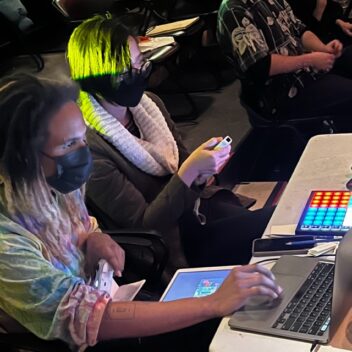
Image: Christopher-Elizabeth Boyd strumming a guitar (Em Quenneville).
Controlling the Stage
Pure Research 32 – Christopher-Elizabeth Boyd
Research focus
This experiment explores giving the audience control of lighting and sound elements using familiar video game controllers. Imagine using an Xbox joystick to control a moving light, or strumming a Rockband guitar to transition between hundreds of pre-loaded sound effects. Naturally, the only way to ensure that this system works is to invite clowns to improvise a real-life in-person video game where the audience becomes the player.
Collaborators and credits
Christopher Elizabeth-Boyd, with clowns Michelle Blight, Kole Durnford, Robert Morrison, Kendelle Parks, and Jacob Willis; Nightswimming’s Brian Quirt, Gloria Mok and Associate Dramaturg Nathaniel Hanula-James, as well as Tarragon Theatre’s Mike Payette and Myekah Payne.
Pure Research Toronto 2023 is a partnership with Tarragon Theatre. All studio sessions were hosted in Tarragon Theatre’s Extraspace, January 18-20, 2023 with technician David Mallette.
Research Notes
Research statement from Chris-Liz:
I love video games. A group of designers, directors and programmers create a world where players are free to play. A game is incomplete without a player, who in a game is also the audience. My favourite games have interactive and responsive worlds, which instills a sense of liveness in the player.
I love theatre. A group of designers, director and technicians create a world where actors can play in. A production is incomplete without an audience. My favourite productions take full advantage of the presence of audience. They can give prompts, ask questions, join the stage, but what about controlling the stage? The lights? The sound?
The reason we don’t do this is simple, the equipment is expensive, there’s a major learning curve, lighting boards look terrifying blah blah blah. You know what’s not terrifying? A Rockband guitar. An Xbox controller, a keyboard. These are all objects that are designed with ease of use in mind.
In my research project with Nightswimming, I am designing and programming a theatre space to be controlled with video game controllers, in a way that is intuitive for audiences and actors to improvise and play with. For example, using a joystick to control a moving light, holding down a button to transition between scenes, or operating a simple sound board loaded with 256 sound effects.
Naturally, the only way to ensure that this system works is to invite clowns to play around with it, and develop a game that they can play with an audience. A real-life in person video game. Where the audience becomes the player.
Final Report
